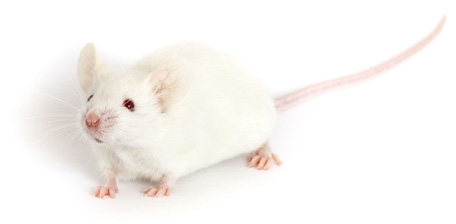According to the Centers for Disease Control, typhoid fever afflicts over 20,000,000 and kills approximately 200,000 people each year, mostly from developing countries. It is transmitted through contaminated food or water by a Gram-negative bacterium called Salmonella enterica serovar typhi (S. typhi). Current therapies and vaccines are woefully inadequate and many multi-drug resistant S. typhi strains have developed. Furthermore, because humans are the only known host of S. typhi, the development of more effective therapies has been slow. That may soon change. A research team led by Dr. Ferric C. Fang of the University of Washington School of Medicine, Seattle, Wash., and including Jackson Laboratory Professor Leonard Shultz, Ph.D., demonstrated that humanized JAX® Mice strain NOD.Cg-Prkdcscid Il2rgtm1Wjl/SzJ (005557, abbreviated NSG for NOD scid gamma) can be infected with S. typhi and serve as a clinically relevant model for the disease (Libby et al. 2010).
Salmonella bacteria have acquired features that uniquely equip them to invade and survive in the human intestine, including the ability to resist phagocytosis; avoid being killed by complement or macrophages; and suppress innate inflammatory responses. Additionally, they possess virulence factors controlled by a multitude of regulators. Most of our understanding of Salmonella pathogenesis comes from studies of another bacterium, S. typhimuriumin, in mice. Unfortunately, S. typhimuriumin has different infectious properties that prevent it from being a true model for S. typhi infection: it possesses some different virulence factors, has several extra genetic islands and elicits very different innate and adaptive immune responses. In addition, mutations that attenuate S. typhimuriumin’s virulence don't attenuate S. typhi's virulence.
Our understanding of S. typhi has improved considerably since the development of humanized mice, highly immunodeficient mice that develop a human immune system from engrafted human hematopoietic stem cells. Dr. Fang and his team demonstrated that the NSG mouse is a particularly useful model for studying human typhoid. It has severe defects in innate and adaptive immunity that permit engraftment of human cells and tissues, including blood cells. Harboring the severe combined immune deficiency (scid) mutation and lacking the IL2 receptor common g-chain, its IL2, IL4, IL7, IL9, IL15, and IL21 receptor-binding and signaling pathways are blocked, resulting in its complete inability to produce mature T cell, B cell, and NK (natural killer) cells.
Sub-lethally irradiated newborn NSG mice engrafted with CD34+ hematopoietic stem cells from T cell-depleted human umbilical cord blood develop a human immune system that includes human B cells, CD4+ and CD8+ T cells, NK cells, monocytes, and myeloid and plasmacytoid dendritic cells (Brehm et al. 2010; Pearson et al. 2008).

Fang and his team found that humanized NSG mice are very susceptible to S. typhi infection, dying within two to three days of intraperitoneal injection. In contrast, non-humanized NSG, immunodeficient NOD.CB17-Prkdcscid/J (001303), and immunocompetent NOD/ShiLtJ (001976) mice survive similar infections relatively unscathed. The livers and spleens of infected humanized NSG mice harbor 10 to 100 times more S. typhi bacteria than those of non-humanized controls and contain the same kinds of pathologies as those found in typhoid-infected humans.
Additionally, the inflammatory cytokine profile in infected humanized NSG mice is similar to that in humans with typhoid. Using a microarray-based strategy, Fang and his team found that the spleens and livers of infected humanized NSG mice contain both known and previously unknown Salmonella virulence determinants, including Salmonella Pathogenicity Islands 1, 2, 3, 4, and 6.
The S. typhi-infected humanized NSG mouse exhibits many human typhoid pathologies. It will shed much-needed light on typhoid pathogenesis, help develop typhoid vaccines and improve strategies for preventing and treating S. typhi infections.
References
Brehm MA, et al. 2010. Parameters for establishing humanized mouse models to study human immunity: Analysis of human hematopoietic stem cell engraftment in three immunodeficient strains of mice bearing the IL2rgamma(null) mutation. Clin Immunol 135:84-98.
Libby SJ, Brehm MA, Greiner DL, Shultz LD, McClelland M, Smith KD, Cookson BT, Karlinsey JE, Kinkel TL, Porwollik S, Canals R, Cummings LA, Fang FC. 2010. Humanized nonobese diabetic-scid IL2r{gamma}null mice are susceptible to lethal Salmonella Typhi infection. Proc Natl Acad Sci U S A Aug 16. [Epub ahead of print].
Pearson T, Greiner DL, Shultz LD. 2008. Creation of "humanized" mice to study human immunity. Curr Protoc Immunol 15:21.